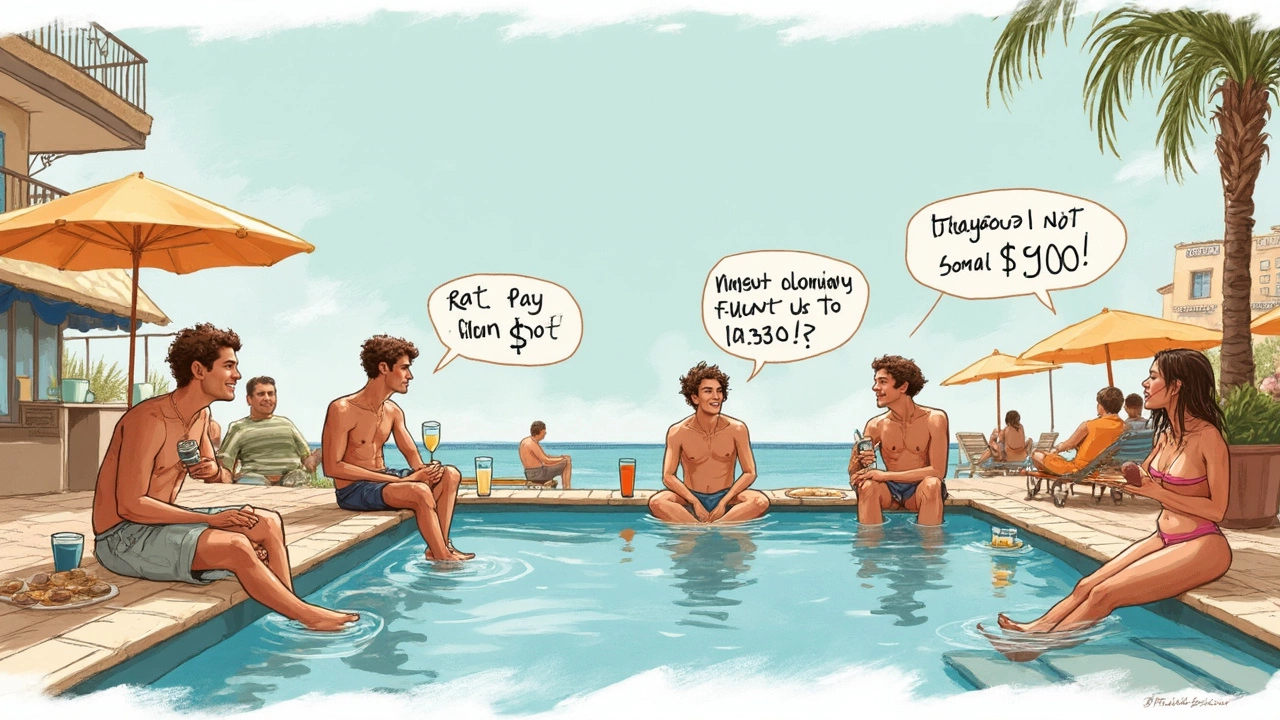Is It Cheaper to Go All-Inclusive? Breaking Down the Real Costs of Your Hotel Stay
27 Apr, 2025Ever looked at an all-inclusive deal and wondered if it's too good to be true? The appeal is obvious: pay once, eat and drink all you want, and lounge around without worrying if you’re blowing your budget on overpriced cocktails.
But here’s the catch—what you see on the booking site isn’t always the whole story. Not every 'all-inclusive' actually covers everything. Some places sneak in charges for premium brands, fancy restaurants, or those fun extras like jet skis and spa sessions. It can feel like you need a microscope to find all the rules.
If you want to figure out whether going all-inclusive actually saves you cash, you have to look beyond the flashy price tag. It’s not just about the room. It’s food, drinks, tips, activities, and sometimes even airport transfers. Stack that up against what you’d pay if you booked everything on your own—meals, drinks, stuff to do, and little surprises like daily resort fees.
Let’s get real and break down when all-inclusive deals put more money back in your pocket—and when they don’t.
- What Does All-Inclusive Really Mean?
- Price Comparisons: The Math Behind It
- Hidden Costs and Surprises
- Tips to Get the Most Value
- When All-Inclusive Makes (or Doesn't Make) Sense
What Does All-Inclusive Really Mean?
The term all-inclusive gets thrown around a lot, but what’s actually covered depends on the hotel. The basic promise is simple: everything you need for your stay—room, food, most drinks, and some activities—is included in one price. But, and it’s a big but, every hotel has its own definition.
Most all-inclusive hotels cover meals at the main buffet, basic drinks (both alcoholic and non-alcoholic), snacks, and a few activities like pool games or beach volleyball. Some places throw in water sports, shows, kids’ clubs, and airport transportation. But don’t count on everything being free. Anything labeled "premium" usually slips through the all-inclusive net—think steakhouse dinners, imported whiskey, spa treatments, or room service.
Here’s what you’ll typically find included at most big resort brands:
- Buffet meals and sometimes a few à la carte restaurants (reservations might be needed)
- Unlimited basic cocktails, beer, house wine, soft drinks, bottled water
- Access to pools, the beach, and standard non-motorized water sports (like kayaks or paddleboards)
- Daily entertainment and scheduled group activities
- Some places include airport transfers, but double-check!
To really know what’s included before you book, check the hotel’s website or ask for a detailed breakdown. One study in 2023 showed that more than 40% of travelers who booked an all-inclusive hotel ended up paying extra for things they thought were already included—mostly specialty dining, motorized sports, and Wi-Fi upgrades.
Bottom line: every resort’s fine print is different. Read it closely, especially if you don’t want surprises at checkout. If something sounds too good to be true, it probably comes with an asterisk.
Price Comparisons: The Math Behind It
Alright, let’s talk numbers. When you’re staring at an all-inclusive price, it usually looks higher than a regular hotel room. Big shocker, right? But you have to remember—you’re not just paying for a bed. You’re also covering daily meals, snacks, drinks, and sometimes a bunch of activities. If you add those up separately, the difference might surprise you.
Here’s a sample daily breakdown for a couple at a mid-range resort:
| Item | All-Inclusive | Pay-As-You-Go |
|---|---|---|
| Room | $220 | $120 |
| Meals (breakfast, lunch, dinner) | Included | $90 |
| Alcohol/Sodas | Included | $50 |
| Snacks | Included | $15 |
| Activities (non-motorized) | Included | $30 |
| Daily Total | $220 | $305 |
So, you might pay $220 upfront, but if you go à la carte, it can hit $305 for a typical day—eating out, grabbing drinks, and joining a few activities. Over a week, that’s a big gap.
Bigger resorts, especially those popular in Mexico or the Caribbean, usually stack the odds in your favor if you enjoy a few drinks, eat three meals a day, and want something to do besides sunbathe. But if you’re the type to skip meals, or you’ll be out sightseeing, that all-in price might go to waste.
A good rule of thumb? Plan your daily routine and add up what you’d realistically spend. If you’re a foodie, love poolside drinks, or have kids who snack all day, all-inclusive almost always works out cheaper. But light eaters and explorers might save going pay-as-you-go. Use your own habits, not just sticker prices, to do the math.
- Check if the package includes extras like Wi-Fi, tips, or transfers to dodge hidden charges.
- Look for deals—sometimes resorts throw in "kids stay free" or resort credits, making all-inclusive pricing even sweeter.
- Don't forget taxes and fees: sometimes those sneak onto your bill at the end.

Hidden Costs and Surprises
So you booked an all-inclusive resort thinking everything’s covered. But then the surprises start rolling in. Some of these can catch even seasoned travelers off guard. Here’s what most people don’t realize until they see that extra charge on checkout:
- Premium Drinks: Sure, beer and house wine are usually covered, but want a craft cocktail, fresh smoothie, or top-shelf whiskey? Many resorts charge extra for anything above the basics. Sometimes, these drinks cost as much as they would at a fancy bar back home.
- Specialty Restaurants: Not all dining is created equal. The main buffet is usually included, but if you want sushi night, a steakhouse dinner, or a lobster lunch, expect extra fees or strict limits on reservations. Some places give you a set number of "a la carte" nights, and after that, it’s pay-as-you-go.
- Activities and Excursions: Beach volleyball and water aerobics? Free. Scuba diving, ziplining, or spa treatments? Those will cost you. Even stuff like paddleboards and snorkeling gear may only be included for an hour, then come with an hourly rental fee.
- Resort Fees and Tips: A lot of all-inclusive resorts in places like Mexico and the Caribbean tack on “resort fees” that aren’t included in the headline price. And while gratuities are sometimes covered, staff may still expect tips, especially for bartenders, servers, and housekeeping.
- Kids’ Clubs, Wi-Fi, and Room Service: These seem like basic perks, but some hotels charge extra for a few hours of kids’ club supervision, fast Wi-Fi, or late-night room service. Even minibar snacks might not be free.
Here's what it can look like in reality:
| Extra | Typical Extra Cost (per person, per day) |
|---|---|
| Premium Drinks | $12-$18 per drink |
| Specialty Dining | $30-$60 per meal |
| Spa Session | $70-$200 |
| Excursion (offsite) | $40-$150 |
| Kids’ Club (extended hours) | $10-$50 |
If you’re on a tight vacation budget, it pays to read the fine print before booking. Check the resort’s website for what’s actually included and—just as important—what isn’t. It can make a big difference in what you end up actually spending on your supposedly all-inclusive trip.
Tips to Get the Most Value
Scoring the best bang for your buck at a all-inclusive resort takes a little planning. It’s not just about the upfront price—it’s about what you actually use and how you avoid sneaky extra costs.
First up, always check the fine print. Not every package covers the same stuff. Some "all-inclusive" hotels limit fancy restaurants, slice off certain drinks, and charge extra for things like room service or water sports. Pay attention before booking, or you might pay more later.
- Meal strategy: Take advantage of every meal and snack included in your rate. Some resorts lay out killer buffets, others have a la carte menus you can order from all day. Make the most of paid-for food instead of wandering off to outside restaurants—unless you’re craving something local, then just budget for it.
- Drinks policy: Watch for limits on alcoholic brands, bottled water, or coffee. Some resorts pour top-shelf booze, others stick to local stuff. If access to premium drinks matters, ask before booking or plan to pay a bit extra.
- Free activities: Use the included activities—kayaks, paddle boards, group fitness, or nightly shows. Some spots pack the schedule with free stuff; it’s your chance to try things you wouldn’t pay for separately.
- Tip guidance: In some places, tips are included in the cost, in others, staff rely on extra tips. If you’re not sure, ask or check reviews. Being clear on this up front avoids awkward moments and surprise expenses.
- Special offers: Many all-inclusive resorts run limited-time promos, like free nights or kids staying free. Keep an eye on these deals, especially in non-peak months. You can often get more value for less money.
A lot of travelers forget about simple things, like airport transfers. Some all-inclusive hotels offer pickups and drop-offs for free, while others charge as much as $40 each way. Double check so you’re not stuck haggling with taxi drivers after a long flight.
If you’re into numbers, here’s how perks add up for a typical 5-night stay for two at an average beach all-inclusive:
| Included Value | Average Cost If Paid Separately |
|---|---|
| Meals & Snacks | $350 |
| Drinks | $200 |
| Activities | $120 |
| Transfers | $80 |
| Total Stuff-Covered | $750 |
If you’d spend less than this total booking things on your own (maybe you skip most drinks or eat cheap), then all-inclusive might not be a bargain for you. But if you want everything in one package, squeezing value from all the perks really makes a difference.

When All-Inclusive Makes (or Doesn't Make) Sense
Choosing an all-inclusive hotel works best when your vacation style matches what these packages offer. If you like the idea of staying put, sipping unlimited drinks, joining poolside games, and having meals ready for you three times a day, then all-inclusive is usually a solid bet. This is especially true for trips with kids or big groups—no arguments about splitting the bill, no worries about where to eat, and way less planning stress.
For families, the savings can stack up. A 2024 survey by Travel Weekly showed families cut meal and drink costs by up to 30% when switching from pay-as-you-go resorts to all-inclusive hotels. Adults-only resorts can even be better value when you consider how much cocktails and à la carte dining can rack up on a regular trip.
But there are times when all-inclusive just doesn’t hit the mark. Do you crave adventure outside the hotel? Want to try local restaurants, street food, or unique excursions? Staying at an all-inclusive might end up costing more, since you’re basically paying twice—once for the package, and again for anything fun off the resort. Foodies and explorers might feel boxed in by buffet dining or limited à la carte bookings.
Here are some signs an all-inclusive is right for you:
- You want a simple, predictable vacation budget with no surprises
- You enjoy eating and drinking at the hotel over hunting for local spots
- Kids or teens are traveling with you (kids clubs, snacks, and entertainment included can be a game-changer)
- You plan to stick around the property most days
Flip side, here’s when all-inclusive probably isn’t worth the price:
- You love trying new local restaurants or street food
- Your days are packed with off-property tours and adventures
- You don’t care about unlimited drinks or hotel shows
- You’re looking for a quiet, boutique vibe or want to tailor every meal and activity
Think about what you want from your next trip. If your idea of a vacation is relaxation with everything included, all-inclusive hotels actually do save money and hassle. If exploring is your thing, those same packages can turn into a pricey lock-in.
| Best For | All-Inclusive | Pay-As-You-Go |
|---|---|---|
| Budget Predictability | ✔️ | ❌ |
| Trying Local Eats | ❌ | ✔️ |
| Family Travel Savings | ✔️ | ❌ |
| Exploring the Area | ❌ | ✔️ |

 by
by